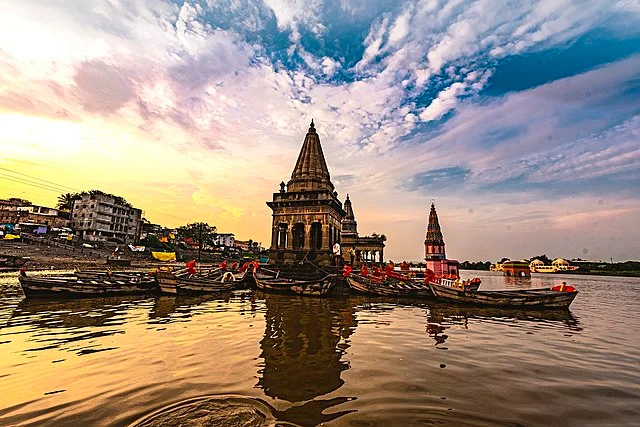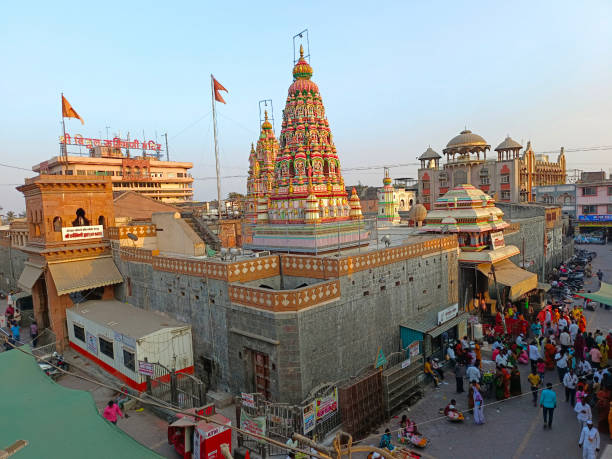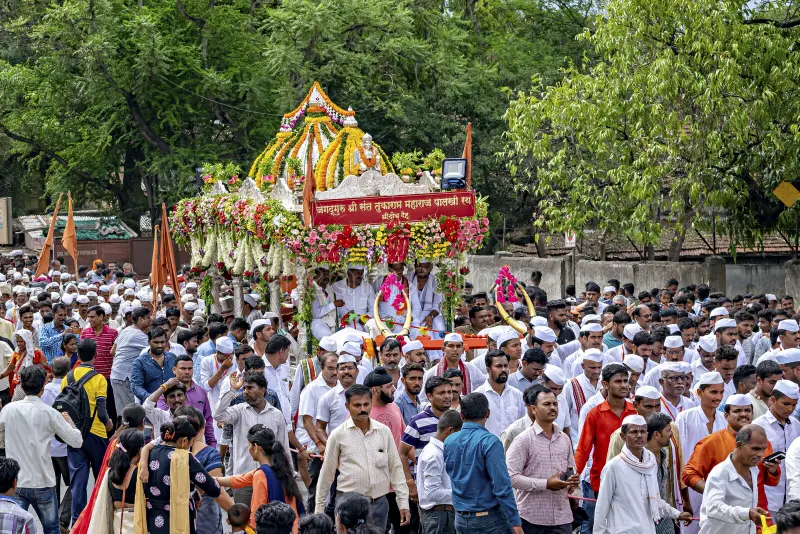
Table of Contents
Pandharpur: The Spiritual Heart of Maharashtra

Pandharpur, a revered town in Maharashtra’s Solapur district, is often referred to as the spiritual capital of the state. It is home to the famous Vitthal-Rukmini Temple, dedicated to Lord Vitthal, a manifestation of Lord Krishna. With a history spanning centuries, Pandharpur is not just a religious center but also a place of immense cultural and historical significance. The town attracts millions of devotees annually, especially during its grand pilgrimages, reinforcing its place in Maharashtra’s spiritual heritage.
The Legend of Pandharpur
Pandharpur’s spiritual essence is rooted in the legend of Pundalik, a devoted son whose selfless service to his parents caught the attention of Lord Vishnu. According to the legend, when Lord Vishnu visited Pundalik’s home, he was so immersed in serving his parents that he offered the Lord a brick (‘Vit’ in Marathi) to stand on while he completed his duty. Impressed by Pundalik’s devotion, Lord Vishnu remained inas Vitthal, blessing devotees who visit his shrine. This story continues to inspire millions and forms the foundation of sacred identity.

Ashadhi Ekadashi and Wari Yatra
One of most defining traditions is the Ashadhi Ekadashi Wari Yatra, an annual pilgrimage that has been observed for over 700 years. Devotees, known as Warkaris, walk from various parts of Maharashtra to Pandharpur, singing devotional hymns and carrying the palanquins (palkhis) of revered saints such as Sant Dnyaneshwar and Sant Tukaram. This pilgrimage culminates in grand celebrations at the Vitthal-Rukmini Temple on Ashadhi Ekadashi. The Kartik Ekadashi Yatra, held later in the year, is another significant event, bringing together thousands of worshippers who seek the blessings of Lord Vitthal.
The Vitthal-Rukmini Temple: A Sacred Abode
The Vitthal-Rukmini Temple is the heart and soul of Pandharpur. Unlike many temples, this shrine offers devotees the unique opportunity to directly touch the feet of the deity, an act considered highly auspicious. The temple complex is always buzzing with energy, filled with chants of “Jai Hari Vitthal” and “Gyanoba Tukaram”, reflecting the deep devotion of the visitors. The temple’s architectural beauty, combined with its spiritual significance, makes it one of the most revered places in India.
A Unique Tradition: Touching the Feet of the Deity
Unlike many temples where devotees can only view the deity from a distance, the Vitthal-Rukmini Temple offers a rare privilege—devotees can directly touch the feet of Lord Vitthal, an act believed to bring immense blessings and spiritual fulfillment. This sacred darshan is known as “Pada Sparsha Darshan”, and devotees wait for hours, sometimes even days, for this divine experience.
The Temple’s Spiritual Atmosphere
The temple complex is always filled with the melodious chants of “Jai Hari Vitthal” and “Gyanoba Tukaram”, creating an atmosphere of divine energy and devotion. Devotees from all walks of life, dressed in traditional attire, can be seen singing Abhangs (devotional hymns), expressing their love for Lord Vitthal.
Inside the temple, the black stone idol of Lord Vitthal stands gracefully, with both hands on his hips—a unique posture that represents his eternal wait for devotees with love and patience. The idol is said to be self-manifested (Swayambhu) and holds immense spiritual significance. Beside Vitthal, the idol of Goddess Rukmini, his consort, is enshrined in a separate sanctum, symbolizing divine love and devotion.
Architectural Grandeur of the Temple
The Vitthal-Rukmini Temple showcases magnificent architecture, blending Yadava and Hemadpanthi styles, which are characteristic of medieval Maharashtra. Some of its notable features include:
- Intricate stone carvings depicting mythological stories
- Massive wooden pillars and beautifully sculpted domes
- Sacred entrances, such as the Namdev Darwaza and Chandrabhaga Darwaza
- A large courtyard that serves as a gathering space for devotees
The temple complex also houses shrines dedicated to various saints and deities, reinforcing its deep spiritual heritage.

Pandharpur and the Bhakti Movement
Pandharpur is a key center of the Bhakti Movement, which emphasized devotion to God over rituals and caste-based divisions. Saints such as Dnyaneshwar, Tukaram, Namdev, Eknath, and many others composed Abhangs (devotional hymns) dedicated to Vitthal. These hymns, rich in spiritual wisdom, continue to resonate with devotees and are an integral part of Maharashtra’s cultural heritage. The teachings of these saints promote unity, selfless devotion, and equality, influencing millions even today.
Saints and Their Teachings
Many revered Bhakti saints from Maharashtra and beyond have enriched the spiritual significance of Pandharpur through their poetry and teachings. Saints like Dnyaneshwar, Tukaram, Namdev, Eknath, Chokhamela, Janabai, and others composed Abhangs (devotional hymns) dedicated to Vitthal. These hymns, filled with spiritual wisdom, love, and surrender to God, continue to inspire devotees.
- Sant Dnyaneshwar emphasized the path of Jnana (knowledge) and Bhakti (devotion), making spiritual wisdom accessible through his work Dnyaneshwari.
- Sant Tukaram preached pure devotion and detachment from material desires, composing numerous Abhangs filled with deep philosophical meaning.
- Sant Namdev was known for his unwavering devotion to Vitthal, spreading Bhakti across Maharashtra and even into North India.
- Sant Eknath worked to bridge societal divisions and taught that true devotion transcends caste and social status.
- Sant Chokhamela, a saint from the so-called “lower caste,” showed that God sees all devotees equally, regardless of social background.
The Chandrabhaga River: A Sacred Lifeline
The Chandrabhaga River, also known as the Bhima River, flows through, adding to the town’s divine charm. Devotees take a holy dip in its waters, believing that it cleanses them of sins and grants spiritual merit. The riverbanks become a hub of activity during major festivals, with thousands gathering for prayers and rituals. The serene flow of Chandrabhaga enhances the spiritual experience of pilgrims visiting this sacred town.
Pandharpur’s Cultural and Economic Significance
Beyond its religious appeal, Pandharpur thrives as a cultural and economic hub. The town’s local markets offer religious artifacts, pedhas (a popular sweet), and traditional Maharashtrian cuisine. The Warkari Sampradaya (sect) has also contributed significantly to preserving the cultural ethos of Maharashtra through its devotional songs and traditions. The influx of pilgrims throughout the year supports the local economy, making religious tourism a vital aspect of identity.

The Everlasting Devotion to Lord Vitthal
Pandharpur’s spiritual legacy continues to grow with every passing year. The unwavering faith of the Warkaris and devotees reflects the timeless devotion to Lord Vitthal. Whether it is through the rhythmic beats of tal (cymbals), the recitation of Abhangs, or the simple act of bowing at the feet of the deity, Pandharpur encapsulates the essence of devotion, unity, and love for the divine.
The Sacred Abode of Lord Vitthal
The main attraction of Pandharpur is the Shri Vitthal-Rukmini Temple. Lord Vitthal, also lovingly called “Vithoba” or “Panduranga,” stands on a brick with his hands on his hips, waiting for his devotees. This unique image of Vitthal symbolizes patience, love, and the bond between God and his devotees. The temple is always filled with chants, prayers, and the sound of devotional songs.
For devotees, visiting Pandharpur is not just a religious act but an emotional journey. People believe that Vitthal listens to everyone with love and blesses them with peace and happiness.
The Wari Tradition – A Journey of Faith
One of the most remarkable aspects of Pandharpur is the Wari tradition. Every year, especially in the months of June and July (Ashadhi Ekadashi), lakhs of devotees, known as “Warkaris,” walk hundreds of kilometers from different parts of Maharashtra to reach Pandharpur.
Carrying the holy “palkhis” (palanquins) of Sant Dnyaneshwar, Sant Tukaram, and other saints, they march with devotion, singing abhangas (devotional songs) and dancing with joy. This centuries-old tradition is not just a pilgrimage but also a living example of unity, discipline, and spiritual strength. The sight of lakhs of people walking together, chanting Vitthal’s name, truly makes Pandharpur the spiritual heart of Maharashtra.
Saints and the Bhakti Movement
Pandharpur is closely associated with the Bhakti movement in Maharashtra. Saints like Sant Dnyaneshwar, Sant Tukaram, Sant Namdev, and Sant Eknath dedicated their lives to spreading devotion to Vitthal. Through their abhangas and teachings, they inspired people to believe in equality, humility, and love for God.
These saints made spirituality accessible to everyone, regardless of caste, class, or background. Their songs are still sung in Pandharpur, filling the air with divine energy and reminding devotees of the eternal bond between Vitthal and his followers.
The Atmosphere of Devotion
Visiting Pandharpur is a unique experience. The narrow streets, filled with shops selling tulsi malas, sweets, and souvenirs, lead to the grand temple. The chants of “Vitthal Vitthal” echo everywhere, creating an atmosphere of devotion. The river Chandrabhaga, which flows beside the town, adds to the sacredness. Many devotees take a holy dip in the river before entering the temple.
During festivals, Pandharpur comes alive with lights, music, and lakhs of pilgrims. The unity of people, the simplicity of devotion, and the energy of collective prayers make the town a living example of faith.
Pandharpur Beyond Religion
While Pandharpur is a major religious destination, it is also a symbol of Maharashtra’s cultural identity. The tradition of Wari, the abhangas of saints, and the devotion of Warkaris are not just spiritual practices but also a way of preserving the rich heritage of the state.
Pandharpur teaches values of equality, devotion, and selfless love. It shows how spirituality can bring people together, inspire social harmony, and guide lives with simplicity and discipline.
Conclusion
Pandharpur is more than just a pilgrimage site; it is a symbol of faith, tradition, and cultural richness. The town’s deep-rooted traditions, grand pilgrimages, and spiritual teachings make it a must-visit for anyone seeking divine blessings and cultural enlightenment. Whether you are a devoted pilgrim or a curious traveler, a visit to Pandharpur promises a soul-stirring journey into the heart of Maharashtra’s spiritual heritage.
“Jai Hari Vitthal!”
Lear More Info
Do Check This Article Too Link
